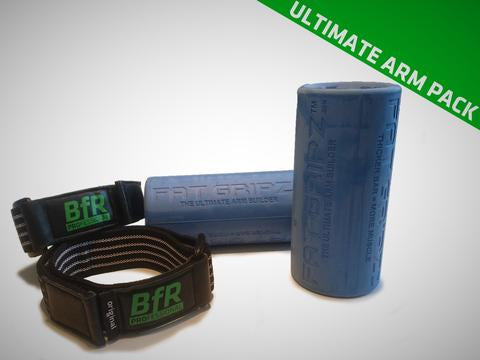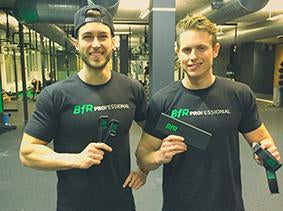5 Tips When Beginning BfR Training

Over the last couple of years, blood flow restriction training has received a lot of positive attention as a result of the amazing increases to size & strength it offers. But many people are still in the dark about how BFR training works. Here are 5 key tips you must know when beginning BFR training.
Warm-Up Correctly
Blood flow restriction training workouts are performed at intensities that are normally used during warm-up sets. As a result, it is suggested that you perform a light warm-up of cardio – such as walking or light cycling – followed by 15 unwrapped repetitions with the weight you will use for your first set of blood flow restriction training.
Choose a Suitable Strap
To perform blood flow restriction training, you will need a device to – you guessed it – restrict blood flow to the limb you wish to train. Whatever you choose, you need to be sure you are only restricting the return blood flow, rather than completely occluding (stopping) it.
There are a number of different suggestions of what to use floating around the internet; from knee wraps to over-sized elastic bands. However, to ensure as accurate a pressure as possible when performing practical BFR training, we suggest purpose designed solutions like our BfR Pro ARMS & BfR Pro LEGS straps.


Once you’ve chosen your bands, make sure you read about where to wrap & how tight in our full How to Wrap Correctly for Blood Flow Restriction Training guide.

Lift MUCH Lighter
This is possibly the biggest advantage of blood flow restriction training – massive increases in muscle size at much lower intensities of weight. Considerable research has been conducted on the optimum weight to lift whilst BFR training depending on the type of goal you are trying to achieve.
To work your slow-twitch fibres (those used for endurance) you should lift around 20-30% of your one-rep max (1RM). Meanwhile, some studies suggest to increase performance of your fast-twitch fibres (those for explosive power and strength) you should lift around 40% of your 1RM.
Adjust Your Reps and Rest Periods
Whilst you are going to be lowering the intensity of weight you’re lifting; you’re going to be upping the intensity and volume of your workout. Blood flow restriction training uses higher metabolically demanding sets & reps with a much shorter rest period between (typically 30-45 seconds).
Aim for 15-30 repetitions for 4 sets with only 30 seconds rest between each set. Concentrate as you squeeze out each rep and feel the movements working the muscles. Squeezing out lifts and shorter rest periods continue to pump blood into your muscle, increases lactic acid build up & create significant growth.
Don’t Over Do It
BFR training results in greater fatigue to the muscle directly following the workout. Therefore, it’s important that you adjust your recovery accordingly but compared to heavy lifting then there is less muscle damage when doing low load BFR training.
Studies have shown that no increases in muscle damage continue longer than 24 hours after a BFR workout[1] meaning it is safe to be performed every other day at most; but the best gains in muscle size and strength have been found performing 2-3 sessions of BFR per week.[2]
Do be aware, however, if you are just starting blood flow restriction training or are unaccustomed to such high-repetition sets, you may need slightly longer to recover from such metabolically demanding training. To begin with, only use BFR training once or twice a week until you feel your muscles are recovering around the 24-hour mark.
Summary
- Be sure to warm up with light cardio & 15 unwrapped reps
- Choose a quality strap and make sure it is applied correctly
- Calculate your new training weight
- Perform longer sets with shorter rest periods
- Listen to your body & don’t over-do it, especially when first starting
Team BfR Professional
Sources:
- Wilson et al, Practical blood flow restriction training increases acute determinants of hypertrophy without increasing indices of muscle damage, The Journal of Strength & Conditioning Research, (2013, 27(11)) 3068-3075.
7 Responses
virginia birkhimer
I am confused between reps and sets. I understand the protocol of 30/15/15/15. Are these numbers considered REPS or SETS? If a pt performs 30/15/15/15, how many TIMES can they perform this? Is 30/15/15/15 reps = ONE SET? If so, how many SETS of this 30/15/15/15 scheme are they permitted to do? I do know that BFRT is not to exceed 15 min on UE
lynn
I’m very interested in this at the moment because I’m 72 and have lost quite a lot of muscle mass and strength in the past year. I’m far from overweight at 8 and a half stone and my aim is to rebuilt muscle mass, strength, stamina and well-being. I understand that this kind of training can actually be helpful to other bodily functions like the brain and the immune system, and presumably, the heart. Any pointers would be very much appreciated. I’ve got my bands ready!
Angel Morales
Learning a lot about BFR. How does BFR. Benefit the chest, lays and glutes. How to increase the muscle size! Thanks Angel
Scott
I think I know the answer already but…my first set I complete 20 to failure. My next set could be 10 reps or 8 or even 5 depending on the lift. I’m working intensively but the rep count isn’t like 3 or 4 sets of 15. Should I just reduce the weight to accommodate the reps? I think I’m at around 50% of my 1 rep max now. I read several articles and they said 50 percent was about the maximum that you’d want to go.
My other question is the length of workout. I’m training fast but absolutely cannot get my workout done in 20 minutes. I know there’s always a premium paid for safety so if you’re extremely healthy and fit can’t you push that time out further? If not how about taking them off and going into a cool down phase without straps and then resuming after 5 to 10 minutes? Thank you
Dixie Popham
can I do BFR every other day. Then lift heaver weights in between.
Darla Hennessey Green
I am a 60 year old women and looking for exercise ideas/example for my age. I am hoping you can make suggestions for me.
Thank you so much!
Morgan
Hi, I’ve been Using occlusion training for a period of time now and it’s great! I have been trying to gather more information about it though. My biggest question is if you should wear the bands the entire workout or should you take off the bands after every 3-4 sets?
Leave a comment
Comments will be approved before showing up.









Lars Thorn
Author